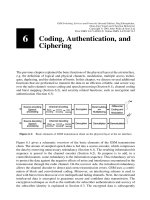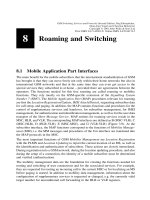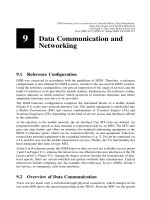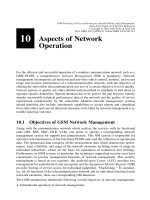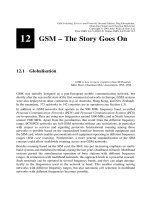Creating services and products
Bạn đang xem bản rút gọn của tài liệu. Xem và tải ngay bản đầy đủ của tài liệu tại đây (13.54 MB, 367 trang )
Creating Services and
Products
v. 1.0
This is the book Creating Services and Products (v. 1.0).
This book is licensed under a Creative Commons by-nc-sa 3.0 ( />3.0/) license. See the license for more details, but that basically means you can share this book as long as you
credit the author (but see below), don't make money from it, and do make it available to everyone else under the
same terms.
This book was accessible as of December 29, 2012, and it was downloaded then by Andy Schmitz
() in an effort to preserve the availability of this book.
Normally, the author and publisher would be credited here. However, the publisher has asked for the customary
Creative Commons attribution to the original publisher, authors, title, and book URI to be removed. Additionally,
per the publisher's request, their name has been removed in some passages. More information is available on this
project's attribution page ( />For more information on the source of this book, or why it is available for free, please see the project's home page
( You can browse or download additional books there.
ii
Table of Contents
Dedication............................................................................................................................... 1
Acknowledgments................................................................................................................. 2
Preface..................................................................................................................................... 4
Chapter 1: Concepts in the Context of Monopolistic Competition ........................... 12
Monopolistic Competition .......................................................................................................................... 14
The Importance of Being Entrepreneurial and Being a Short-Term Monopolist ................................. 16
The Entrepreneur Should Design Products and Services for Continuous Product Differentiation and
Innovation..................................................................................................................................................... 17
Entrepreneurship Can Be Found in Large and Small Companies ........................................................... 18
The Kingpins of Product Differentiation and Entrepreneurial Innovation Activity ............................19
Radical and Incremental Innovation ......................................................................................................... 20
Product and Technology Life Cycles .......................................................................................................... 21
Diffusion of a Technology Usually Lags Performance.............................................................................. 23
Discontinuities, Chasms, and Hype in the Diffusion Process .................................................................. 25
The Bridge Model of Technology Life Cycle .............................................................................................. 27
Technologies Do Not Necessarily Fall Into the Abyss: They Become Embedded in New Technology 28
There is Power in Numbers: Network Effects and Metcalfe’s Law.......................................................... 29
The Role of R&D Process in Innovation ..................................................................................................... 31
Push, Pull, and Reload can go on Forever ................................................................................................. 33
R&D for Start-Ups and Small Businesses ................................................................................................... 34
Search and the Role of Learning-About in Developing Ideas for New Products and Services ............35
Building Things and the Role of Learn-By-Doing in Developing Ideas for New Products and
Services ......................................................................................................................................................... 38
The Role of the Supply Chain and the Brand in Product Differentiation .............................................. 40
Conclusion .................................................................................................................................................... 41
Chapter 2: Fundamentals of Product and Price Differentiation............................... 42
The Demand Curve....................................................................................................................................... 43
First-Degree Price Discrimination: Personalized Pricing ........................................................................ 44
Second-Degree Price Discrimination: Versioning .................................................................................... 48
Third-degree Price Discrimination: Group Pricing .................................................................................. 52
Legal Issues Related to Price Discrimination and Product Differentiation ........................................... 55
Conclusion .................................................................................................................................................... 57
iii
Chapter 3: Differentiation in Action ............................................................................... 58
Price and Product Differentiation and Enlightenment............................................................................ 62
Generating Additional Revenues: Willingness-to-Pay ............................................................................. 66
Demand and Differentiation Dashboards .................................................................................................. 68
Monopolistic Competition at Work............................................................................................................ 70
Independent, Complement, and Substitute Goods and Services ............................................................ 71
Price Discrimination and Price Differentiation ........................................................................................ 73
Irritating Consumers ................................................................................................................................... 74
Waves of Innovation Fueled by Substitutes and Complements .............................................................. 76
Arbitrage: Producer’s Paradise and Consumer’s Dread ........................................................................... 77
Conclusion .................................................................................................................................................... 79
Appendix: Determining the Optimal Selling Price Using Demand, Revenue, and Cost Equations......80
Chapter 4: Dynamic Tension in Versioning and PD Curves ....................................... 89
Product Differentiation Curves .................................................................................................................. 90
Versioning and Goldilocks Pricing ............................................................................................................. 92
Using Dynamic Tension Differentiation to Develop Products and Services for the Entire Demand
Curve ............................................................................................................................................................. 93
Dynamic Tension Between Midas and Hermes Spawns Atlas ................................................................. 96
Midas, Atlas, and Hermes Versions............................................................................................................ 97
Bottom of the Pyramid ................................................................................................................................ 99
Versioning Restaurants, Hotels, and Motels ........................................................................................... 100
Versioning Commodity and Standardized Products .............................................................................. 102
Versioning Strategies ................................................................................................................................ 103
Version Rollout Strategies ........................................................................................................................ 105
Customer Segments and Midas, Atlas, and Hermes Versions ............................................................... 106
Pricing and Product Differentiation Strategies ...................................................................................... 108
Dynamic Tension in Action at Singapore Airlines.................................................................................. 109
Conclusion .................................................................................................................................................. 110
Addendum on Pareto Economics, Welfare, and Efficiency.................................................................... 111
iv
Chapter 5: Examples of Product Differentiation & Versioning Curves ................. 113
Versioning Automobiles............................................................................................................................ 114
Versioning at Dell ...................................................................................................................................... 118
Versioning at Microsoft ............................................................................................................................ 121
Versioning Wireless Communications..................................................................................................... 123
Versioning at Apple ................................................................................................................................... 126
Versioning e-Books.................................................................................................................................... 127
Versioning Digital Content ....................................................................................................................... 129
Versioning Digital Entertainment............................................................................................................ 131
Versioning Disease Treatments................................................................................................................ 133
Conclusion .................................................................................................................................................. 136
Chapter 6: Facilitating Creativity and Innovation..................................................... 137
The Creative Process is Inherently Nonlinear ........................................................................................ 140
The Lonely Genius...................................................................................................................................... 142
The Habits of Successful Entrepreneurs.................................................................................................. 143
Environmental Factors Affecting Creativity and Innovation................................................................ 144
How to Hinder Creativity .......................................................................................................................... 147
Embrace Some Adversity and Avoid Chronic Stress .............................................................................. 148
Creativity Techniques................................................................................................................................ 149
Conclusion .................................................................................................................................................. 154
Chapter 7: Conceptualizing Products/Services Using FAD ...................................... 155
Features, Attributes, Form, Design, Function, and Meaning are Interrelated Concepts ...................156
Meaning and Product Design.................................................................................................................... 158
Functional Design and User Ignored........................................................................................................ 162
Identifying Key Meanings, Attributes, and Features ............................................................................. 163
Design Products and Services that Facilitate Control ............................................................................ 166
Categorizing the Importance of Product Attributes .............................................................................. 168
The FAD Template...................................................................................................................................... 171
Developing Blue Ocean Markets from Complementary Products and Services .................................. 178
Avoid the Swiss Army Knife Approach to Product Differentiation ...................................................... 179
Conclusion .................................................................................................................................................. 181
Exhibit 1: FAD Template ............................................................................................................................ 182
Design and Prototype Product or Service ............................................................................................... 185
Appendix 1: Examples of Prototypes ....................................................................................................... 186
Appendix 2: FAD Template for Wine Aging Product .............................................................................. 188
Design and Prototype Product or Service ............................................................................................... 191
v
Chapter 8: Strategic Planning and Ten–Ten Planning.............................................. 192
Planning Concepts ..................................................................................................................................... 193
The Planning Process................................................................................................................................. 194
Analytical Approaches for Strategic Planning........................................................................................ 196
Conclusion .................................................................................................................................................. 214
Chapter 9: The Ten–Ten Planning Process: Crafting a Business Story ................. 215
Organizational and Industry Analysis Template .................................................................................... 217
Business Plan Overview Template (Mantra, Mission, Money, Goals, Objectives, and Tactics) ..........220
Developing an Executive Summary: Crafting a Business Story ............................................................ 225
Extending the Wine Aging Cooler Example Using the Ten–Ten Templates ........................................ 227
Conclusion .................................................................................................................................................. 228
Appendix: Illustrations of Completed Ten–Ten Templates and an Executive Summary for the
AddVintner Star ......................................................................................................................................... 230
Sample Business Plan ................................................................................................................................ 233
Executive Summary (first draft not for distribution) ............................................................................ 234
Chapter 10: Lock-In and Revenue Growth ................................................................... 236
Lock-In Leads to Network Effects and Increased Product Performance .............................................. 237
Switching Costs are Everywhere .............................................................................................................. 238
A Lock-In Index .......................................................................................................................................... 241
The Downside of Lock-in ........................................................................................................................... 242
Outsourcing and Lock-in ........................................................................................................................... 243
Customer Acquisition, Customer Retention, and Lock-in ..................................................................... 246
Conclusion .................................................................................................................................................. 247
Chapter 11: Valuing the Business.................................................................................. 249
Why are Businesses Bought and Sold?..................................................................................................... 250
Overview of Business Valuation Techniques .......................................................................................... 251
Controlling and Noncontrolling Interests............................................................................................... 252
Specific Valuation Techniques ................................................................................................................. 253
Valuing Start-Up Businesses..................................................................................................................... 268
Examples of Valuation............................................................................................................................... 270
The Importance of Growth Rate on Firm Value...................................................................................... 273
Conclusion .................................................................................................................................................. 275
vi
Chapter 12: Developing a Business Plan ...................................................................... 276
Purpose of the Business Plan .................................................................................................................... 278
Approaches for Developing Business Plans............................................................................................. 279
Prototyping the Product or Service ......................................................................................................... 281
Business Plan Template............................................................................................................................. 282
Writing, Organization, and Formatting: Helping the Reader to Read.................................................. 287
Business Presentation................................................................................................................................ 289
Identifying Potential Investors................................................................................................................. 293
Angel Investors........................................................................................................................................... 296
Venture Capital Funds and Venture Capitalists ..................................................................................... 297
Contingency Planning and Risk................................................................................................................ 299
Due Diligence.............................................................................................................................................. 300
Legal Issues ................................................................................................................................................. 302
Conclusion .................................................................................................................................................. 303
Chapter 13: Project Management for New Products and Services ......................... 305
Building-the-Business Phase..................................................................................................................... 306
Why Project Management is Beneficial ................................................................................................... 311
What is a Project?....................................................................................................................................... 312
Launching the Business or Project ........................................................................................................... 315
Launch Date ................................................................................................................................................ 319
Growing Up and Professional Management............................................................................................ 321
Conclusion .................................................................................................................................................. 323
Exhibit 1: Project Management Individual Diary ................................................................................... 324
Exhibit 2: Project Management Summary Diary .................................................................................... 325
Chapter 14: Re-priming the Business Using Real Options Concepts...................... 327
Investment Decisions................................................................................................................................. 328
Real Options................................................................................................................................................ 331
The Role of Real Options in Investment Decisions ................................................................................. 332
The Influence of Interaction Effects on Investment Decisions ............................................................. 337
The Influence of Competitor’s Response on Investment Decisions...................................................... 338
The Strategic Actions Model: Combining Interaction Effects and Competitor Response ..................339
The Project Selection Model: Considering Risk and Reward................................................................. 341
Conclusion .................................................................................................................................................. 342
Chapter 15: Wrap-Up........................................................................................................ 344
References .......................................................................................................................... 347
vii
Dedication
This book is dedicated to my mother Phyllis Sanders. She is a constant source of
inspiration in my life.
1
Acknowledgments
I would first like to thank the series editor Naresh Malhotra. His guidance and
comments dramatically improved the content and delivery of the material.
I would also like to thank colleagues Bill Hamlen, Ken Kim, Alan Dick, and Yong Li
for providing guidance and reviewing book chapters related to their expertise. I
would also like to thank Larry Meile from Boston College for reading early drafts of
several chapters. His comments helped to focus the theme of the book. Elisabeth
Beccue was very instrumental in her deft copy editing during the final phase of the
book. It would have been very difficult to complete this book without the excellent
administrative assistance and support of Karen Drass. James McMahon provided
invaluable editing assistance of the book and also assisted with the preparation of
the presentation supplements. Thanks are also extended to Keith Randolph, my
source of engineering insight, for listening to my ideas and providing feedback.
It was clear after working on the book for over a year that the complexity and
breadth of topics would require assistance if the book was to be completed in a
reasonable time. Special thanks are extended to the following individuals who
contributed in many ways to the content and structure of the book:
• Ron Huefner assisted with preparing the chapter on firm value. Ron
actually took my initial draft of the chapter and completely rewrote it.
He also read the first draft of the book and provided invaluable
editorial comments.
• Sung Jin assisted with preparing the chapters on lock-in and creativity.
Sung also assisted with a variety of editing activities to get the book
ready for production.
• Yong Jin Kim assisted with preparing the chapter on real options.
• Lorena Mathien assisted with preparing the chapter on project
management.
• Barbara Sherman assisted with preparing the chapter on the FAD
template.
• Xiao Tang assisted with preparing the chapters on strategic planning,
the Ten–Ten planning process, and the chapter on the development of
the business plan. Xiao also assisted with a variety of editing activities
to get the book ready for production.
• Chul Woo Yoo assisted with preparing the chapter on product and
price differentiation and also assisted with preparing the chapter
illustrating how the concepts can be applied.
2
Acknowledgments
Thanks to my spouse Jody and my son Sean for listening to my recount of the
numerous business plans developed by the students and for serving as a sounding
board for several ideas.
Finally, I would like to thank the nearly 1,000 students who pushed me to reach
further and further to formulate and develop the course content.
3
Preface
A central theme of this book is that there is, or should be, a constant struggle going
on in every organization, business, and system. The struggle is fueled by the
dynamic tension that exists between delivering Midas feature-rich versions of
products and services using extravagant engineering and delivering low-cost
Hermes versions of products and services using frugal engineering (see Figure 1).
Midas versions are high-end products for nonprice-sensitive consumers. Hermes
versions are for price-sensitive consumers. The results of this dynamic tension
between Midas versioning and Hermes versioning are Atlas products and services.
Atlas products and services are designed for mainstream consumers. Atlas products
and services incorporate the product design features that will attract the broadest
customer base and will also be profitable. The driving force behind the
development of Midas, Atlas, and Hermes versions is driven by the implicit creative
genius that everyone possess and most businesses should possess as they engage in
continuous learning-about and learn-by-doing activities.
Anyone can learn how to be creative and innovative. Just work hard by learning
about the problem, and then try to solve the problem by making or doing
something. Not all systems and businesses can be creative and innovative. Some
companies can work hard and they can learn about a problem but they cannot build
and do things because they have lost the ability to do so. They have lost the ability
to learn-by-doing.
4
Preface
The Dueling Mantras
Our primary mantra for a business is “differentiate through innovation or perish.”
This is accomplished primarily through extravagant engineering and design and
the construction of Midas versions. This is not an easy path to follow, because there
is a natural tendency toward inertia and resting on one's laurels.We do not believe
that technology and new product development should be pursued with abandon
and without analysis. We do believe that bandwagon effects can occur and that
unbridled enthusiasm can lead to faulty business models and major mistakes. A
sound planning process can alleviate many of these issues. It is our assertion that
creative and innovative business planning driven by learning-about and learningby-doing leads to sustainable businesses. Our focus will be on the upfront activities
and ideas for product and service differentiation that result in competitive products
and services. They include the endless cycle of business planning, creative and
innovative insight, learning-about, and learning-by-doing.
The second mantra of the entrepreneur is to “strive to reduce costs.” This is
accomplished primarily through frugal engineering and design and the
construction of Hermes versions. Some organizations have been overly enthusiastic
in embracing this mantra. In some businesses, learning-by-doing has been
abandoned in an attempt to dramatically cut costs and increase margins in the
wake of intense international competition. But this has had a negative impact on
the ability of many organizations to innovate, because many companies have lost
the ability to exploit new knowledge and information when it becomes available.
Many organizations have lost what is referred to as absorptive capacity. Absorptive
capacity is the ability of a firm to “recognize the value of new information,
assimilate it, and apply it to commercial ends.”Cohen and Levinthal (1990), p. 128. It
is the ability to apply previously gained knowledge and insight to understanding
how new information and knowledge can be applied. Developing absorptive
capacity is synonymous with developing insight. Insight is the ability to perceive
complex situations, problems and opportunities clearly and deeply. Andy Grove, a
past founder and CEO of Intel, pegs the current situation perfectly:
Silicon Valley is a community with a strong tradition of engineering, and engineers
are a peculiar breed. They are eager to solve whatever problems they encounter. If
profit margins are the problem, we go to work on margins, with exquisite focus.
Each company, ruggedly individualistic, does its best to expand efficiently and
improve its own profitability. However, our pursuit of our individual businesses,
which often involves transferring manufacturing and a great deal of engineering
out of the country, has hindered our ability to bring innovations to scale at home.
Without scaling, we don't just lose jobs—we lose our hold on new technologies.
Losing the ability to scale will ultimately damage our capacity to innovate.Grove
(2010).
5
Preface
The USA is losing the ability to compete in high-tech fields in part because it has
abandoned learning-by-doing. Basic research and applied research involving broadbased collaboration by government, academia, and business are essential for solving
societal problems and in providing a base for technology-based businesses.Pisano
and Shih (2009). Basic research involves understating the fundamental principles
and dynamics of physics, chemistry, biology, and cybernetics to name a few.
Applied research involves translating the principles and dynamics of basic research
into commercial applications. The U.S. government up to about 1990 distributed
about the same amount of funds to both basic and applied research projects. In
recent years, the gap between basic research funding and applied research funding
has been widening. The U.S. government has provided less money for applied
research.Pisano and Shih (2009).
Outsourcing has also reduced the level of applied research. New product
development is essentially applied research. New product development is facilitated
when an organization has core competencies in research and development (R&D),
product design, and manufacturing. Everyone is beginning to realize that there is a
synergistic interplay between R&D, product design, marketing, and manufacturing.
New product development is put at risk when these activities are outsourced, offshored, or both. Entire industries are affected as the knowledge is not readily
available for solving problems and realizing new opportunities essentially because
it is embedded elsewhere.
Learning-by-Doing as the Basis for Competitiveness and
Sustainability
Learning-by-doing means that the organization makes and builds things, conducts
experiments, and builds prototypes. This includes the manufacturing process. The
loss of absorptive capacity insight can often be traced to outsourcing. Outsourcing
typically occurs when products and service margins are under severe market
pressure, and organizations are forced to increase productivity by turning to
locations where labor costs are substantially lower. This can have serious
consequences. If the organization loses its absorptive capacity, then the
organization may not be able to understand and recognize when an emerging
technology is important. In essence, the organization does not have the ability to
acquire know-how, expertise and skills because it has lost the ability to learn-bydoing and learn-about emerging ideas and technologies. Grove's solution to
recapturing creative and innovative mojo is to reduce costs by also increasing the
scale of operations. The essence of his idea is that if an organization can produce
more, it will also be able to take advantage of learning effects and to cover the fixed
costs of production. Intel is committed to product differentiation, scale and cost
reduction, in-house manufacturing, and in-house design. Long-term sustainability
6
Preface
is inextricably linked to the synergistic interplay of design, manufacturing, and
market awareness.
There is a revolution taking place in all businesses. Additive and desktop
manufacturing, open-source software, and the do-it-yourself movement are fueling
this revolution. Products and components can be conceptualized, designed, and
built using 3D printers. These printers use a process that is similar to building up
layers of plastic and composite materials to build products and parts and to
prototype ideas. A do-it-yourselfer can assemble such a printer for under $1,000. A
commercial printer can be obtained in the $10–$20K range. The products produced
from these printers can be used to produce commercial products and for
prototyping. Large-scale 3D printers are being developed to produce products and
components the size of aircraft wings. There is also a revolution taking place in the
development of services. Cloud computing, applications development tools, and
open-source software are having a profound impact on the delivery of softwarerelated services and applications. Software start-ups and prototypes can be
constructed without investing in large-scale hardware infrastructure. The software
itself can be cobbled together with a variety of development tools and open-source
software. Competition can come from any size of company from anywhere in the
world. All that is needed is an idea, hard work, and experimentation.
The Big Aha and Learning-by-doing
As we shall see throughout the book, the magic sauce of innovation involves
learning and experimentation. Weaving together the little ahas through a
continuous learning process is the basis of interesting ideas and innovation. As
illustrated in Figure 2, learning-about and learning-by-doing are the drivers of
innovation and new product development. This process involves the continuous
mixing together of collaboration, searching for ideas, and then making things. As
noted in Chapter 6 "Facilitating Creativity and Innovation", the little ahas
eventually lead to the big aha and the big aha is not necessarily the solution to the
original problem. The big aha is simply illuminating, insightful, and innovative.
Peter Sims suggests the placing of little bets to explore possibilities and engage in
innovation.Sims (2011). Little bets are essentially low-risk investments with a
chance of failure that incorporate the development and testing of ideas. Placing
little bets leads to little ahas and eventually to the big aha. Placing little bets are
actually investments in what are referred to as real options, and that topic will be
covered in depth in Chapter 14 "Re-priming the Business Using Real Options
Concepts".
7
Preface
There are of course other important issues in the execution of a successful business,
including the development of an efficient supply chain and the development of a
strong brand. The supply chain and developing a brand are discussed throughout
the book, but they deserve more attention and detail and the reader is encouraged
to learn-about these topics by reading and attending professional development
programs. As noted in Chapter 8 "Strategic Planning and Ten–Ten Planning",
organizations need above-average performance in terms of product and service
innovation, the supply chain, and branding in order to survive.
Book Chapters
This book is concerned primarily with the early stages of conceptualizing new ideas
that can enhance existing business models and subsequently lead to the creation of
new businesses (see Figure 3). The material in this book has been in development
over the last 10 years in a course on technology management and development. One
purpose of the course is to understand how technologies unfold and how they guide
the strategic direction of contemporary business. The course involves reading and
discussing over a dozen cases a wide variety of successful, emerging, and
unsuccessful businesses. The cases used in the course are usually matched to
chapter topics. The case studies and class dialog coupled with the reading of the
8
Preface
book chapters are part of the learning-about process. The learn-by-doing part of
the course involves the development of a business plan for a start-up company.
• Chapter 1 "Concepts in the Context of Monopolistic Competition"
introduces the fundamental concepts related to understanding
innovation, diffusion, technology life cycles, R&D, and
entrepreneurship within the context of monopolistic competition. The
importance of learning-about and learning-by-doing for developing
innovative products and services is discussed.
• Chapter 2 "Fundamentals of Product and Price Differentiation"
illustrates the importance of product and price differentiation and how
they relate to a consumer's willingness-to-pay and to price
sensitivities. The chapter also describes first-, second-, and thirddegree price discrimination strategies and how they can be
implemented.
• Chapter 3 "Differentiation in Action" illustrates why product
differentiation and price discrimination can generate additional
revenues. The chapter focuses on the use of versioning to aid in
product differentiation. A spreadsheet is dashboard presented that can
be used to assist in product versioning. The importance of
complementary and substitute goods and their impact on revenues is
also examined.
• Chapter 4 "Dynamic Tension in Versioning and PD Curves"
illustrates a model for constructing product differentiation curves that
draws on the dynamic tension that exists between developing high-end
Midas products and low-end Hermes products. The results of this
dynamic tension between Midas versioning and Hermes versioning are
9
Preface
•
•
•
•
•
•
•
Atlas products and services. Atlas products and services are designed
for mainstream consumers.
Chapter 5 "Examples of Product Differentiation & Versioning
Curves" shows a variety of product differentiation and versioning
strategies that have been used by businesses. Some businesses focus on
versioning at the high end, some businesses focus on price-sensitive
consumers, and some businesses try to offer products across the entire
demand curve.
Chapter 6 "Facilitating Creativity and Innovation" discusses the
concepts of creativity and innovation. Fostering creativity and
innovative activity can be accomplished by dialog and discussion,
learning-about, encouragement, time, solitude, experimentation,
construction, and by having a supportive environment.
Chapter 7 "Conceptualizing Products/Services Using FAD"
introduces the FAD (features, attributes, and design) template. The FAD
template is used to identify the features and attributes that can be used
for product and service differentiation. The FAD template incorporates
concepts from meaning-driven design (MDD), user-driven design
(UDD), and technology-driven design (TDD) and also uses a
classification scheme that can be used to ascertain whether attributes
and features are increasing or declining in importance.
Chapter 8 "Strategic Planning and Ten–Ten Planning" presents a
brief overview of the more popular approaches for strategic planning.
This chapter also sets the stage for the Ten–Ten planning process, a
simplified yet robust approach to planning that will be detailed in
Chapter 9 "The Ten–Ten Planning Process: Crafting a Business Story".
Chapter 9 "The Ten–Ten Planning Process: Crafting a Business
Story" details the Ten–Ten planning process. The Ten–Ten planning
process contains two templates: an Organizational and Industry
Analysis template and the Business Plan Overview template. The idea
behind the Ten–Ten approach is that once you have gathered some
background data related to the industry and the organization, you
should be able to complete the two very quickly. The chapter also
describes how the Business Plan Overview template and the Industry
and Organizational template in conjunction with the FAD template can
be used to develop an executive summary for the business plan.
Chapter 10 "Lock-In and Revenue Growth" discusses the importance
of lock-in from the producer's perspective in achieving revenue goals
through network effects. The chapter also highlights how buyers try to
avoid lock-in in order to maintain flexibility and avoid switching costs.
The entrepreneur, the entrepreneur's friends and family, investors,
and banks are interested in how much a business is worth. Chapter 11
"Valuing the Business" discusses several approaches for valuing a
business and presents several examples of how they can be applied.
10
Preface
• Chapter 12 "Developing a Business Plan" presents a detailed
approach for constructing a business plan. The expanded business plan
provides additional focus by adding details on the what, why, how,
when, and for whom a product or service will be produced. The FAD
template, the Organizational and Industry Analysis template, the
Business Plan Overview template and the executive summary are used
as the basis for developing a full-scale business plan. A variety of issues
are also discussed including the plan format, the writing style,
investors, and legal issues. This chapter also discusses how to pitch the
plan to interested parties.
• Chapter 13 "Project Management for New Products and Services"
presents an overview of the essential tools and techniques for project
management. Once the initial business model has been created, the
hard work begins. In most situations, everything is new and needs to
be built up from scratch. The entire supply chain has to be built and
tested to insure that orders for products and services can be accepted,
filled, and supported. Project management is a critical tool in the
never-ending process of business growth and renewal. It allows the
entrepreneur to minimize and mitigate inherent risks and increase the
potential for the successful launch of the enterprise and the ensuing
business renewal.
• Chapter 14 "Re-priming the Business Using Real Options Concepts"
is about business renewal. It does not matter how innovative or how
much money the current business is making. There is a life cycle for
products and technologies, and eventually the business will decline
unless it can find new opportunities. This chapter focuses on how real
options concepts can be used as the foundation for continually
reinventing the business.
• Chapter 15 "Wrap-Up" discusses the importance of being
entrepreneurial in renewal. If a business does not make little and big
tweaks to products and services, it will become a business footnote.
The ideas presented in this book will not guarantee success, but they
can be used to confront and also to ignore the competition by
identifying and creating opportunities that supersede the competition.
11
Chapter 1
Concepts in the Context of Monopolistic Competition
Dominant Types of Markets
I always like to start class with a pop quiz. It is a good way to get the old gray matter
going and stirs up a bit of angst and loathing. There are only three matching
questions and they all relate to the dominant types of markets: (1) perfectly
competitive markets1, (2) perfectly monopolistic markets2, and (3) the market
hybrid referred to as monopolistic competition3.
Question 1: Match the market types with their definition
1. Perfectly competitive
market
a. Many sellers trading a similar product to many
buyers
2. Monopoly market
b. One seller trading a similar product to many
buyers
3. Monopolistic
competition market
c. Many sellers trading a slightly differentiated
product to many buyers
If you matched 1 with a, 2 with b, and 3 with c, give yourself one point.
Question 2: Now match the types of markets with their percentages of
total activity
1. Perfectly competitive market
a. Less than 1%
2. Monopoly market
b. Less than 1%
3. Monopolistic competition market
c. Over 99%
If you matched 1 with a, 2 with b, and 3 with c, give yourself one point.
1. Many sellers trading a similar
product to many buyers.
2. One seller trading a similar
product to many buyers.
3. Many sellers trading a slightly
differentiated product to many
buyers.
Question 3: Now match the type of market that is easiest to enter
1. Perfectly competitive market
a. Somewhat easy to enter
2. Monopoly market
b. Very difficult to enter
3. Monopolistic competition market
c. Very easy to enter
12
Chapter 1 Concepts in the Context of Monopolistic Competition
If you matched 1 with a, 2 with b, and 3 with c, give yourself one point.
Give yourself a passing grade if you get above a zero.By the way, I detest pop
quizzes. They may work to force people to read the material, but they make
learning miserable. Based on the description of the three types of markets, this
brief questionnaire illustrates that the best place, and perhaps the only place for
entrepreneurs to compete is in markets characterized by monopolistic completion.
13
Chapter 1 Concepts in the Context of Monopolistic Competition
1.1 Monopolistic Competition
Edward Chamberlin published the foundations of monopolistic competition in his
1933 book entitled The Theory of Monopolistic Competition. It is considered by some
economists to have the same stature as John Maynard Keynes’s General Theory in
revolutionizing economic thought in the 20th century.Brakman and Heijdra (2004).
The idea behind monopolistic competition is simple in form and powerful in
practice.
Monopolistic competition involves many buyers, many sellers, and easy exit and
entry, with slightly differentiated products. The sellers in these markets sell
products that are closely related, but not identical. They have features that
differentiate them from the competition. Usually, the buyers and sellers also have
good information on the attributes of the products and the prices of the products in
the marketplace. Indeed, most products and services are sold in markets
characterized by monopolistic competition. The list includes jewelry, movie
production, food, entertainment, many electronic gadgets and components, some
durable goods, books, crafts, soda, houses, cars, consulting businesses, software,
game consoles, restaurants, bars, and so forth.
A monopolist4 is a price setter and a business competing in a perfectly competitive
market is a price taker. Most businesses strive to be price setters within a certain
range of prices by offering a product that is closely related, but not exactly identical
to other products in the market. The key strategy for competing in markets
characterized by monopolistic competition is to offer products that are
differentiated. The products are sort of quasi-substitutes, but they still resemble the
original product or service. For example, Apple developed the iPod to compete with
existing MP3 players.
4. A price setter.
According to standard economic theory, a purely competitive market has many
buyers and sellers and each individual firm is a price taker. In essence, consumers
and producers determine the market price for a product or service. In perfectly
competitive markets, there are many sellers and buyers, and entry into and out of
the market is easy. In a perfectly competitive market, companies sell their products
at prevailing market prices where marginal revenue equals marginal cost. In
actuality, every business would like to control the market, set the price, and be a
monopolist. All businesses should strive to compete as a monopolist, even if it is in
the short term. The goal is to rake in lots of money in the short term because your
company is the only seller of a slightly differentiated product or service.An
oligopoly is a special case of a monopoly. There are a small number of firms (e.g.,
2–8) and they control more than 50% of the market. An oligopolistic market is
14
Chapter 1 Concepts in the Context of Monopolistic Competition
characterized by low levels of product differentiation and very high fixed costs of
entry, where competition is often based on price with elements of both price taking
and price leadership. Sample sectors include steel, copper, autos, breakfast cereals,
tires, some appliances, and home-care equipment. See McConnell, Brue, and
Campbell (2004). This will be short term (unless you have an exclusive patent on a
product, own a large oil field, or have exclusive rights to providing cable or utility
services) because successful products will always attract the competition. The only
way to compete in contemporary markets is to become a serial entrepreneur, to
constantly refine and reposition your products, and to function as a nearmonopolist in the short term.
1.1 Monopolistic Competition
15
Chapter 1 Concepts in the Context of Monopolistic Competition
1.2 The Importance of Being Entrepreneurial and Being a Short-Term
Monopolist
The notion of the entrepreneurial enterprise as a monopolist is not new. Indeed, it
has a long tradition and history. KirznerKirzner (1973). noted in 1973 that
entrepreneurship may be a step to monopoly power. It is possible to acquire market
power by adding unique features or services that are not offered by the
competition. When the unique features of a product are combined with a wellthought-out production and distribution process and an understanding of the
competitive environment, the results are usually positive. This knowledge and the
unique knowledge resources are of course transitory, but in the short run they can
provide for near-monopoly power.
Entrepreneurship is currently being viewed as a set of skills that are part of a
rational and logical process for identifying and creating opportunities.Sarasvathy
and Venkataraman (2008). The process and the skills have been likened to learning
how to read, write, calculate, and conduct scientific reasoning. Being a successful
entrepreneur requires insight and knowledge of problem solving, strategic
planning, new product development, project management, and portfolio
management among others. An important reason for participating in the
entrepreneurial process is that it involves a significant amount of making and
building things. This, in turn, leads to learning-by-doing and the creation of new
unforeseen opportunities because you have been participating in the
entrepreneurial process. Participation in entrepreneurial activity leads to the
creation of opportunities in the form of products and services that were not even
conceptualized or anticipated in the beginning. The entrepreneurial process
actually creates new markets via innovation and product differentiation. Our
definition of entrepreneurship focuses on a continuous process for creating new
and enhanced products and services.
Entrepreneurship5 is a risky endeavor involving the continuous creation and recreation of a new enterprise, a new product, or a new idea.
5. A risky endeavor involving the
continuous creation and recreation of a new enterprise, a
new product, or a new idea.
The origin of the word entrepreneur can be traced to Old French. Entrepreneurs6
were individuals who undertook risky endeavors such as theatrical productions.
Risk is an inherent part of entrepreneurship. If there is no risk involved and there is
still money to be made, then the endeavor is probably a gift.
6. Individuals who undertook
risky endeavors such as
theatrical productions.
16
Chapter 1 Concepts in the Context of Monopolistic Competition
1.3 The Entrepreneur Should Design Products and Services for
Continuous Product Differentiation and Innovation
Developments in economics, marketing, operations management, and information
technology have now brought the vision of customization and personalization to
reality.Arora et al. (2008). Consumers want products and services tailored to their
personal needs, but they also want products that are standardized, mass produced,
and inexpensive. It is possible to assemble products and services using standardized
processes and standardized modular components and still achieve product
differentiation. Autos, global positioning systems (GPSs), tax software, operating
systems, refrigerators, and so forth are all designed so that features and
performance can be easily added and subtracted. The key principle in designing
products and services is to design for flexibility and to continuously improve those
products and services. This is the essence of a product differentiation strategy and
the only way to survive under monopolistic competition.
17
Chapter 1 Concepts in the Context of Monopolistic Competition
1.4 Entrepreneurship Can Be Found in Large and Small Companies
Large companies can be entrepreneurial, but as a company scales up it is difficult to
maintain entrepreneurial momentum. For example, several promising employees
left Google for the relatively entrepreneurial environment of Facebook.Miller (2010,
November 28). This is a natural phenomenon in high-tech enclaves such as Silicon
Valley, but there was reason for concern because Google had grown to 23,000+
employees. Google was being viewed as slow and lumbering, too bureaucratic, and
too slow to respond to the innovative possibilities of emerging technologies. Google
has taken several steps to retain entrepreneurial talent by permitting them to work
independently and letting them recruit individuals with relevant skills.
It does not matter if a firm is a gigantic monolithic multinational or a small start-up
company manufacturing kazoos or even a mom and pop organization designing and
launching Web services. The objective is the same: design products and services
that are new and unique, easily differentiable, and adaptable to the needs of
consumers. Entrepreneurial guru, blogger, and author Guy Kawasaki describes the
situation perfectly:
A great company anticipates what a customer needs—even before she knows she
wants it … the key to driving the competition crazy is outinnovating, outservicing,
and outpricing … Create a great product or service, put it out there, see who falls in
love with it …Kawasaki (2008).
18

